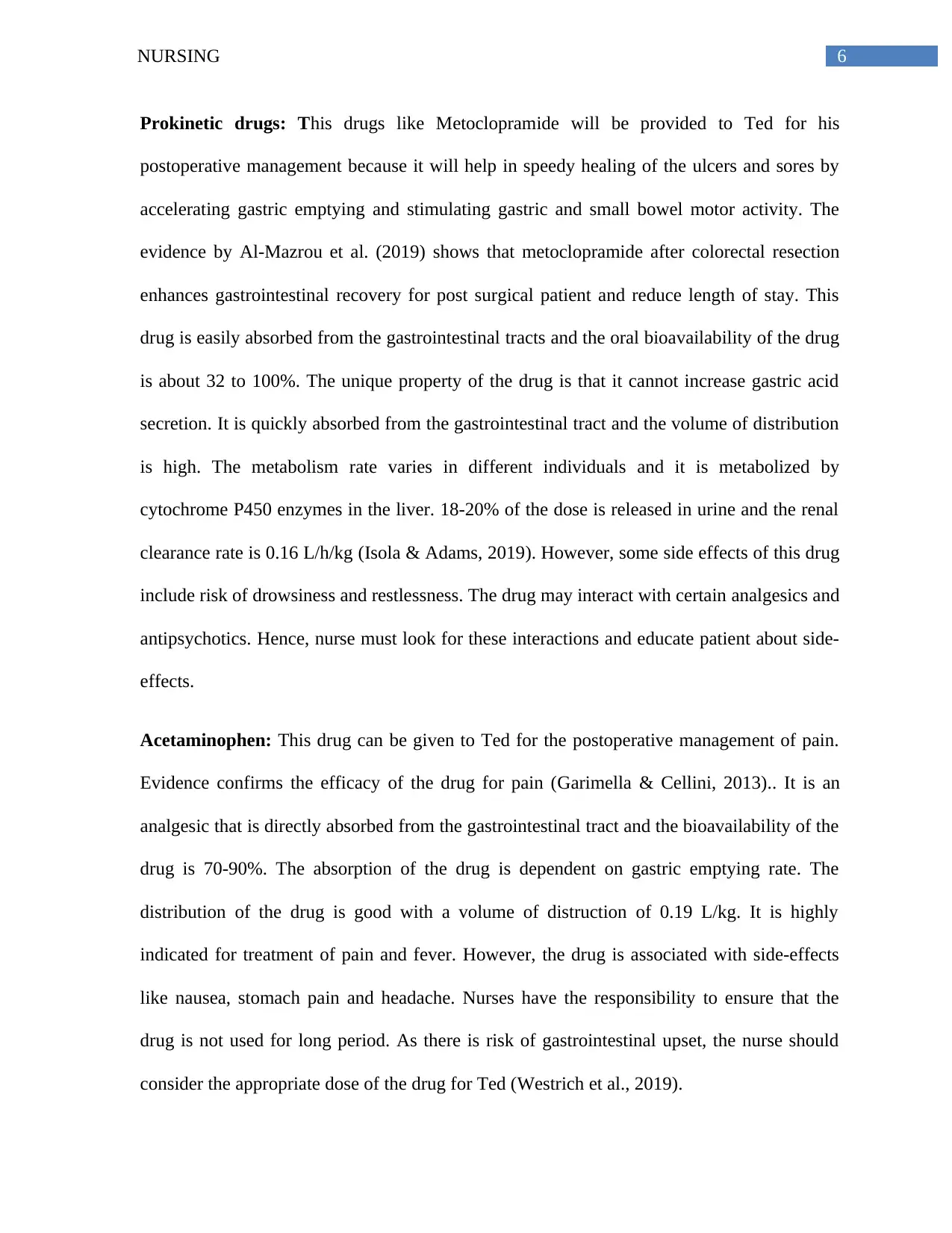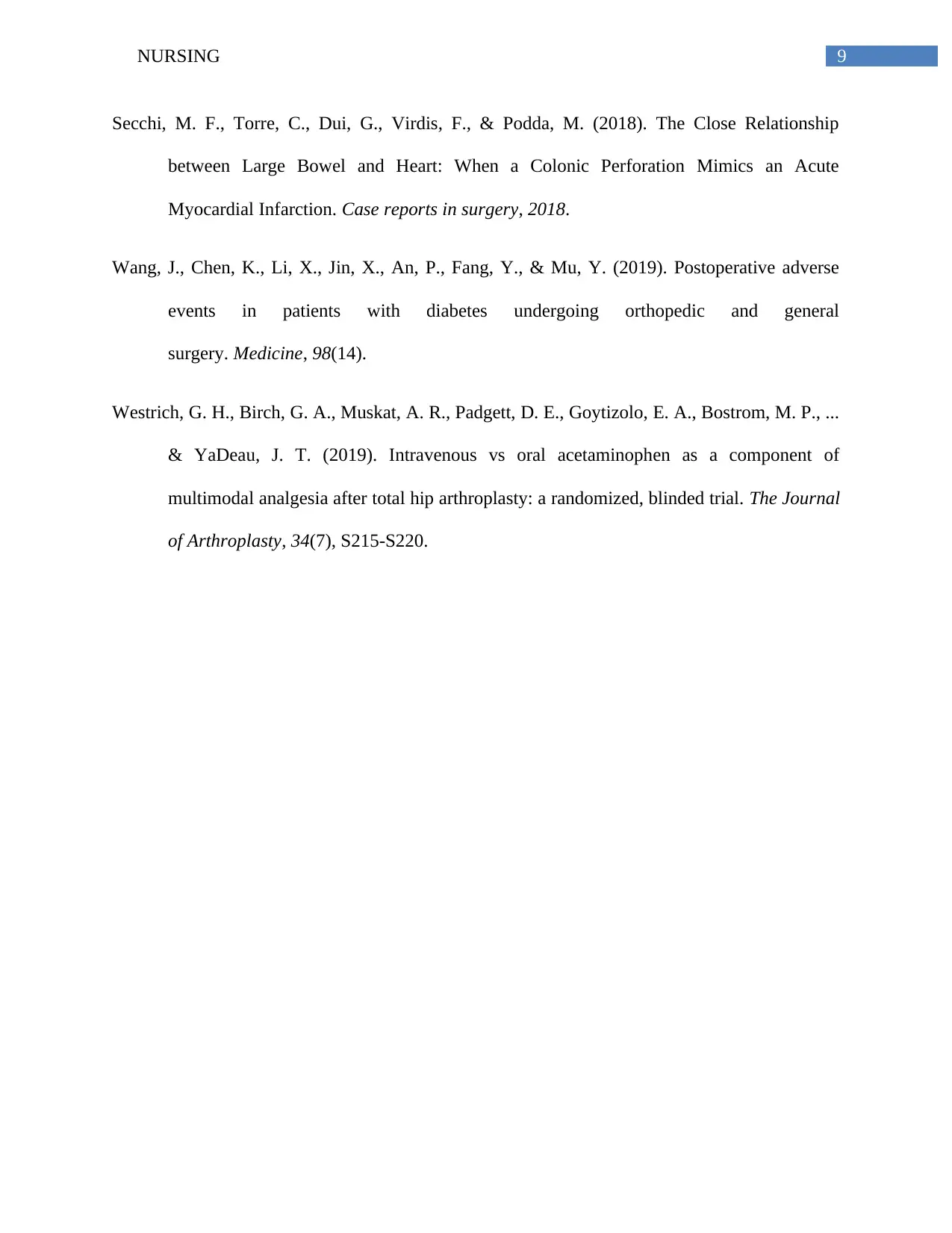Edward Williams Surgery docx.
VerifiedAdded on 2022/07/28
|10
|2944
|16
AI Summary
Contribute Materials
Your contribution can guide someone’s learning journey. Share your
documents today.

Running head: NURSING
Nursing
Name of the student:
Name of the University:
Author’s note
Nursing
Name of the student:
Name of the University:
Author’s note
Secure Best Marks with AI Grader
Need help grading? Try our AI Grader for instant feedback on your assignments.

1NURSING
Answer 1
Edward (Ted) Williams was an 82 year old male who undergone a bowel resection and
engaged in formation of a temporary colostomy. This surgery is likely to have many impacts on
patient. Firstly, the patient is likely to be physically affected by the surgery as due to the effect of
the surgery, the patient may suffer from intense pain, discomfort and changes in vital signs. Erb,
Hyman Osler (2014) confirms that abnormal vital signs and pain are common after bowel
resection and this occurs because of anastomotic leakage or other postoperative complications
after surgery. Secondly, Edward is likely to suffer from negative psychosocial consequences
because of changes in his activity of daily living due to colostomy formation. For example,
washing and dressing changes will be difficult because of the colostomy bag and the incision.
There will be significance change in postoperative lifestyle. For example, clothing styles needs
to changed, diet needs to be modified and motion needs to be changed (Anaraki et al., 2012).
Due to extreme changes in lifestyle, Ted is likely to suffer from depression, anxiety and poor
self-esteem too. Ayaz‐Alkaya (2019) gives the evidence that stoma formation cause various
psychological and social problems to patient leading to low self-esteem, poor body image,
loneliness, hopelessness and stigmatization. They experienced social problems too evidenced by
loss of interest in social activities, decreased working ability, poor partner relationship and
avoiding travel. Ted is likely to suffer from the same too. Ted is likely to be spiritually and
culturally affected post stoma formation as changes in the above areas will affect spiritual well-
being and disrupt Ted’s ability to engage in cultural and spiritual activities (Rafiei et al., 2018).
Answer 1
Edward (Ted) Williams was an 82 year old male who undergone a bowel resection and
engaged in formation of a temporary colostomy. This surgery is likely to have many impacts on
patient. Firstly, the patient is likely to be physically affected by the surgery as due to the effect of
the surgery, the patient may suffer from intense pain, discomfort and changes in vital signs. Erb,
Hyman Osler (2014) confirms that abnormal vital signs and pain are common after bowel
resection and this occurs because of anastomotic leakage or other postoperative complications
after surgery. Secondly, Edward is likely to suffer from negative psychosocial consequences
because of changes in his activity of daily living due to colostomy formation. For example,
washing and dressing changes will be difficult because of the colostomy bag and the incision.
There will be significance change in postoperative lifestyle. For example, clothing styles needs
to changed, diet needs to be modified and motion needs to be changed (Anaraki et al., 2012).
Due to extreme changes in lifestyle, Ted is likely to suffer from depression, anxiety and poor
self-esteem too. Ayaz‐Alkaya (2019) gives the evidence that stoma formation cause various
psychological and social problems to patient leading to low self-esteem, poor body image,
loneliness, hopelessness and stigmatization. They experienced social problems too evidenced by
loss of interest in social activities, decreased working ability, poor partner relationship and
avoiding travel. Ted is likely to suffer from the same too. Ted is likely to be spiritually and
culturally affected post stoma formation as changes in the above areas will affect spiritual well-
being and disrupt Ted’s ability to engage in cultural and spiritual activities (Rafiei et al., 2018).

2NURSING
Answer 2
As Ted is in day 4 days post bowel resection, evaluation of his current and sign and
symptoms is crucial to identify key problems faced by him currently. His vital signs on day 4 at
10 am revealed the following: T 38.1; HR 98 reg; BP 135/85; RR 26; SpO2 94% on 3L NP. His
heart rate is within normal limits, however his RR value is high as the normal RR is 12 to 20
breaths/minute. His BP is found to be abnormal too. Such form of changes in vital sign is seen
in patients with bowel resection due to the effect of the surgery. Ted is found to have fever too.
Such changes in temperature and blood pressure are most common in patients in the first post-
operative week. These signs are indications of some complications post surgery and anastomotic
leak is one of the causes behind it (Erb, Hyman Osler, 2014). In case of Ted, the inspection of his
occlusive dressing revealed no drainage from the wound. Hence, there might be other cause
behind changes in his vital signs. Looking at his past medical history of heart failure, diabetes,
obesity and gout, it can be said these disease might be influencing his post-operative outcomes.
For instance, patient with high glucose level may have high likelihood of postoperative
complications as hyperglycemia is a risk factor for postoperative sepsis, poor wound healing and
endothelial dysfunction. Stress due to trauma and operative blood loss might be the cause behind
change in his vital signs too (Wang et al., 2019). According to Secchi et al. (2018), systemic
inflammatory response leads to clinical manifestation of fever, tachycardia, tachypnea,
intraabdominal abscesses and elevated inflammatory markers in patients with heart failure.
Hence, Ted’s abnormal vital changes may be influenced by the stress of the surgery or his past
medical history.
The second issue for Ted post operation is his abdomen pain. He has verbalized abdomen
pain of 4-5/10 and expressed that the pain increases to 7/10 on palpation. This might be
Answer 2
As Ted is in day 4 days post bowel resection, evaluation of his current and sign and
symptoms is crucial to identify key problems faced by him currently. His vital signs on day 4 at
10 am revealed the following: T 38.1; HR 98 reg; BP 135/85; RR 26; SpO2 94% on 3L NP. His
heart rate is within normal limits, however his RR value is high as the normal RR is 12 to 20
breaths/minute. His BP is found to be abnormal too. Such form of changes in vital sign is seen
in patients with bowel resection due to the effect of the surgery. Ted is found to have fever too.
Such changes in temperature and blood pressure are most common in patients in the first post-
operative week. These signs are indications of some complications post surgery and anastomotic
leak is one of the causes behind it (Erb, Hyman Osler, 2014). In case of Ted, the inspection of his
occlusive dressing revealed no drainage from the wound. Hence, there might be other cause
behind changes in his vital signs. Looking at his past medical history of heart failure, diabetes,
obesity and gout, it can be said these disease might be influencing his post-operative outcomes.
For instance, patient with high glucose level may have high likelihood of postoperative
complications as hyperglycemia is a risk factor for postoperative sepsis, poor wound healing and
endothelial dysfunction. Stress due to trauma and operative blood loss might be the cause behind
change in his vital signs too (Wang et al., 2019). According to Secchi et al. (2018), systemic
inflammatory response leads to clinical manifestation of fever, tachycardia, tachypnea,
intraabdominal abscesses and elevated inflammatory markers in patients with heart failure.
Hence, Ted’s abnormal vital changes may be influenced by the stress of the surgery or his past
medical history.
The second issue for Ted post operation is his abdomen pain. He has verbalized abdomen
pain of 4-5/10 and expressed that the pain increases to 7/10 on palpation. This might be

3NURSING
occurring due to the incision as he has been operated just 4 days ago and the incision area may
not have healed. Due to the surgery in the abdomen area, damage to the ilioguinal nerve and the
iliohypogastric nerve occurs. Such damage might be the cause behind pain. The clinical features
that distinguish abdominal pain from other pain include abdominal tenderness, nausea and
increase in pain severity due to posture. Such form of abdominal pain occurs due to the
possibility of an adhesion around the surgical scar (Kijima et al.., 2019). Ted was also
experiencing similar issue. Ted has not passed flatus and this might be linked to his increase in
discomfort too. To promote recovery of Ted, active management and regulation of abdominal
pain will be crucial. During clinical examination, Ted was found with right sided inspiratory
coarse crackles and moist productive cough. Inspiratory crackles with productive or non
productive cough is a sign of pneumonia and this is most commonly seen in post surgery patient.
Managing this is important to prevent unnecessary stress to the stoma and incision area.
Answer 3:
Based on the evaluation of current clinical symptoms and health needs of Mr Ted, it is
planned to implement the following five nursing intervention for patient:
1. Acute pain: The first goal of care is to reduce pain scores of Ted evidenced by verbal
scores pain, changes in vital signs and anxiety in patient. To alleviate pain, it is planned
to provide multiple pharmacologic drugs to reduce nociceptor activation and inhibiting
the production of pain neurotransmitters. Opiod analgesics like morphine are the standard
drug for pain management of patient with colostomy. As Ted was already taking
morphine, this can be combined with nonsteroidal anti-inflammatory agents (NSAIDs) to
engage in better management of pain (Garimella & Cellini, 2013). This can be followed
occurring due to the incision as he has been operated just 4 days ago and the incision area may
not have healed. Due to the surgery in the abdomen area, damage to the ilioguinal nerve and the
iliohypogastric nerve occurs. Such damage might be the cause behind pain. The clinical features
that distinguish abdominal pain from other pain include abdominal tenderness, nausea and
increase in pain severity due to posture. Such form of abdominal pain occurs due to the
possibility of an adhesion around the surgical scar (Kijima et al.., 2019). Ted was also
experiencing similar issue. Ted has not passed flatus and this might be linked to his increase in
discomfort too. To promote recovery of Ted, active management and regulation of abdominal
pain will be crucial. During clinical examination, Ted was found with right sided inspiratory
coarse crackles and moist productive cough. Inspiratory crackles with productive or non
productive cough is a sign of pneumonia and this is most commonly seen in post surgery patient.
Managing this is important to prevent unnecessary stress to the stoma and incision area.
Answer 3:
Based on the evaluation of current clinical symptoms and health needs of Mr Ted, it is
planned to implement the following five nursing intervention for patient:
1. Acute pain: The first goal of care is to reduce pain scores of Ted evidenced by verbal
scores pain, changes in vital signs and anxiety in patient. To alleviate pain, it is planned
to provide multiple pharmacologic drugs to reduce nociceptor activation and inhibiting
the production of pain neurotransmitters. Opiod analgesics like morphine are the standard
drug for pain management of patient with colostomy. As Ted was already taking
morphine, this can be combined with nonsteroidal anti-inflammatory agents (NSAIDs) to
engage in better management of pain (Garimella & Cellini, 2013). This can be followed
Secure Best Marks with AI Grader
Need help grading? Try our AI Grader for instant feedback on your assignments.

4NURSING
up with regular assessment of pain and providing comfort measures such as back rub or
respositioning to reduce discomfort of patient ().
2. Maintaining skin integrity of the stoma: As Ted has been operated 4 days ago, taking
care of stoma will be important. The goal will be to maintain skin integrity and consider
risk factors that could complicate condition of Ted. This will be done by regular
inspection of the stoma after each pouch change and looking for symptoms of irritation,
bruises and rashes. This form of stomal inspection can help in the early identification of
necrosis or fungal infection. One of the important criteria for care of the stoma is to keep
skin around the stoma dry after each pouch change. This will be done by washing the
skin with warm water and dry it completely before attaching the pouch. Application of
appropriate skin barrier like hydrocolloid water will be important to protect skin from fro
pouch adhesive (Kwiatt & Kawata, 2013). Another important activity is empty, irrigate
and change the ostomy bag on a regular basis. This step can help to maintain integrity of
the stoma (Medline Plus, 2020).
3. Managing risk of constipation: Ted was found to have sluggish bowel sound and he had
not passed flatus. All these symptoms are risk factors of constipation. Managing risk
factors of constipation and flatulence is critical because if this is not managed, it will lead
to additional discomfort for Ted. This will be done by auscultating bowel sounds,
reviewing dietary pattern and making proper changes to the diet. Mr. Ted needs to be
provided food items that are rich in fibre and roughage to promote consistency of stool.
Regular irrigation of the stoma can also treat complications (Kuczynska et al., 2017).
Review of medication is also important for the client because constipation may occur due
to the side-effects of medication too. If dietary changes are not successful, then
up with regular assessment of pain and providing comfort measures such as back rub or
respositioning to reduce discomfort of patient ().
2. Maintaining skin integrity of the stoma: As Ted has been operated 4 days ago, taking
care of stoma will be important. The goal will be to maintain skin integrity and consider
risk factors that could complicate condition of Ted. This will be done by regular
inspection of the stoma after each pouch change and looking for symptoms of irritation,
bruises and rashes. This form of stomal inspection can help in the early identification of
necrosis or fungal infection. One of the important criteria for care of the stoma is to keep
skin around the stoma dry after each pouch change. This will be done by washing the
skin with warm water and dry it completely before attaching the pouch. Application of
appropriate skin barrier like hydrocolloid water will be important to protect skin from fro
pouch adhesive (Kwiatt & Kawata, 2013). Another important activity is empty, irrigate
and change the ostomy bag on a regular basis. This step can help to maintain integrity of
the stoma (Medline Plus, 2020).
3. Managing risk of constipation: Ted was found to have sluggish bowel sound and he had
not passed flatus. All these symptoms are risk factors of constipation. Managing risk
factors of constipation and flatulence is critical because if this is not managed, it will lead
to additional discomfort for Ted. This will be done by auscultating bowel sounds,
reviewing dietary pattern and making proper changes to the diet. Mr. Ted needs to be
provided food items that are rich in fibre and roughage to promote consistency of stool.
Regular irrigation of the stoma can also treat complications (Kuczynska et al., 2017).
Review of medication is also important for the client because constipation may occur due
to the side-effects of medication too. If dietary changes are not successful, then

5NURSING
pharmacological interventions like use of laxatives should be given to patient (Krokowicz
et al., 2015).
4. Management of vital signs of patient: As Mr. Ted is showing changes in his vital signs
such as increase in respiratory rate and blood pressure, this might be due to fluid volume
deficits or the influence of other factors like his past medical history of diabetes and heart
failure. To manage risk of hypertension, it will be necessary to administer angiotensin
receptor blockers (ARBs) and angiotensin converting enzyme inhibitors to patient. This
will help in the management of his blood pressure levels. According to Omboni and
Volpe (2018), ARBs are effective in lowering BP and promoting reduction of
cardiovascular risk too. Hence, use of this drug is important for Ted considering the fact
that he is a patient with heart failure. In additional, administering IV fluid and electrolytes
will help to maintain tissue perfusion for the patient. High output stoma can increase the
risk of dehydration and electrolyte imbalance and use of correction fluids and diet
modification can help to resolve the problem (Raju, Sheshagiri & Shenoy, 2018).
5. Reduce psychosocial impact of colostomy: As Ted is at risk of anxiety, there is a need
to educate patient about colostomy, ways to identify complications and live with stoma
on a daily basis. This would help to increase confidence of patient and strengthen their
emotional and psychological will power to self-manage the disease. Proper written and
verbal instruction on stomal care would help to promote positive management of the
condition. Danielsen, Burcharth and Rosenberg (2013) justifies that patient education
can meet psychosocial needs of patient and have positive impact on quality of life too.
Answer 4
pharmacological interventions like use of laxatives should be given to patient (Krokowicz
et al., 2015).
4. Management of vital signs of patient: As Mr. Ted is showing changes in his vital signs
such as increase in respiratory rate and blood pressure, this might be due to fluid volume
deficits or the influence of other factors like his past medical history of diabetes and heart
failure. To manage risk of hypertension, it will be necessary to administer angiotensin
receptor blockers (ARBs) and angiotensin converting enzyme inhibitors to patient. This
will help in the management of his blood pressure levels. According to Omboni and
Volpe (2018), ARBs are effective in lowering BP and promoting reduction of
cardiovascular risk too. Hence, use of this drug is important for Ted considering the fact
that he is a patient with heart failure. In additional, administering IV fluid and electrolytes
will help to maintain tissue perfusion for the patient. High output stoma can increase the
risk of dehydration and electrolyte imbalance and use of correction fluids and diet
modification can help to resolve the problem (Raju, Sheshagiri & Shenoy, 2018).
5. Reduce psychosocial impact of colostomy: As Ted is at risk of anxiety, there is a need
to educate patient about colostomy, ways to identify complications and live with stoma
on a daily basis. This would help to increase confidence of patient and strengthen their
emotional and psychological will power to self-manage the disease. Proper written and
verbal instruction on stomal care would help to promote positive management of the
condition. Danielsen, Burcharth and Rosenberg (2013) justifies that patient education
can meet psychosocial needs of patient and have positive impact on quality of life too.
Answer 4

6NURSING
Prokinetic drugs: This drugs like Metoclopramide will be provided to Ted for his
postoperative management because it will help in speedy healing of the ulcers and sores by
accelerating gastric emptying and stimulating gastric and small bowel motor activity. The
evidence by Al-Mazrou et al. (2019) shows that metoclopramide after colorectal resection
enhances gastrointestinal recovery for post surgical patient and reduce length of stay. This
drug is easily absorbed from the gastrointestinal tracts and the oral bioavailability of the drug
is about 32 to 100%. The unique property of the drug is that it cannot increase gastric acid
secretion. It is quickly absorbed from the gastrointestinal tract and the volume of distribution
is high. The metabolism rate varies in different individuals and it is metabolized by
cytochrome P450 enzymes in the liver. 18-20% of the dose is released in urine and the renal
clearance rate is 0.16 L/h/kg (Isola & Adams, 2019). However, some side effects of this drug
include risk of drowsiness and restlessness. The drug may interact with certain analgesics and
antipsychotics. Hence, nurse must look for these interactions and educate patient about side-
effects.
Acetaminophen: This drug can be given to Ted for the postoperative management of pain.
Evidence confirms the efficacy of the drug for pain (Garimella & Cellini, 2013).. It is an
analgesic that is directly absorbed from the gastrointestinal tract and the bioavailability of the
drug is 70-90%. The absorption of the drug is dependent on gastric emptying rate. The
distribution of the drug is good with a volume of distruction of 0.19 L/kg. It is highly
indicated for treatment of pain and fever. However, the drug is associated with side-effects
like nausea, stomach pain and headache. Nurses have the responsibility to ensure that the
drug is not used for long period. As there is risk of gastrointestinal upset, the nurse should
consider the appropriate dose of the drug for Ted (Westrich et al., 2019).
Prokinetic drugs: This drugs like Metoclopramide will be provided to Ted for his
postoperative management because it will help in speedy healing of the ulcers and sores by
accelerating gastric emptying and stimulating gastric and small bowel motor activity. The
evidence by Al-Mazrou et al. (2019) shows that metoclopramide after colorectal resection
enhances gastrointestinal recovery for post surgical patient and reduce length of stay. This
drug is easily absorbed from the gastrointestinal tracts and the oral bioavailability of the drug
is about 32 to 100%. The unique property of the drug is that it cannot increase gastric acid
secretion. It is quickly absorbed from the gastrointestinal tract and the volume of distribution
is high. The metabolism rate varies in different individuals and it is metabolized by
cytochrome P450 enzymes in the liver. 18-20% of the dose is released in urine and the renal
clearance rate is 0.16 L/h/kg (Isola & Adams, 2019). However, some side effects of this drug
include risk of drowsiness and restlessness. The drug may interact with certain analgesics and
antipsychotics. Hence, nurse must look for these interactions and educate patient about side-
effects.
Acetaminophen: This drug can be given to Ted for the postoperative management of pain.
Evidence confirms the efficacy of the drug for pain (Garimella & Cellini, 2013).. It is an
analgesic that is directly absorbed from the gastrointestinal tract and the bioavailability of the
drug is 70-90%. The absorption of the drug is dependent on gastric emptying rate. The
distribution of the drug is good with a volume of distruction of 0.19 L/kg. It is highly
indicated for treatment of pain and fever. However, the drug is associated with side-effects
like nausea, stomach pain and headache. Nurses have the responsibility to ensure that the
drug is not used for long period. As there is risk of gastrointestinal upset, the nurse should
consider the appropriate dose of the drug for Ted (Westrich et al., 2019).
Paraphrase This Document
Need a fresh take? Get an instant paraphrase of this document with our AI Paraphraser

7NURSING
References:
Al-Mazrou, A. M., Toledano, S., Valizadeh, N., Suradkar, K., Kuritzkes, B., Hyde, L., ... &
Kiran, R. P. (2017). Metoclopramide after Colorectal Resection Enhances
Gastrointestinal Recovery and Reduces Length of Stay. Gastroenterology, 152(5), S1302.
Anaraki, F., Vafaie, M., Behboo, R., Maghsoodi, N., Esmaeilpour, S., & Safaee, A. (2012).
Clinical profile and post-operative lifestyle changes in cancer and non-cancer patients
with ostomy. Gastroenterology and hepatology from bed to bench, 5(Suppl 1), S26–S30.
Ayaz‐Alkaya, S. (2019). Overview of psychosocial problems in individuals with stoma: A
review of literature. International wound journal, 16(1), 243-249.
Danielsen, A. K., Burcharth, J., & Rosenberg, J. (2013). Patient education has a positive effect in
patients with a stoma: a systematic review. Colorectal Disease, 15(6), e276-e283.
Erb, L., Hyman, N. H., & Osler, T. (2014). Abnormal vital signs are common after bowel
resection and do not predict anastomotic leak. Journal of the American College of
Surgeons, 218(6), 1195-1199.
Garimella, V., & Cellini, C. (2013). Postoperative pain control. Clinics in colon and rectal
surgery, 26(3), 191–196. https://doi.org/10.1055/s-0033-1351138
Isola, S., & Adams, N. (2019). Metoclopramide. In StatPearls [Internet]. StatPearls Publishing.
Kijima, T., Hyakudomi, R., Hashimoto, T., Kusaka, A., Nakatani, T., & Ishibashi, Y. (2019).
Adhesion-induced chronic abdominal pain: a case report on the diagnostic value of
Carnett’s test. Journal of medical case reports, 13(1), 93
References:
Al-Mazrou, A. M., Toledano, S., Valizadeh, N., Suradkar, K., Kuritzkes, B., Hyde, L., ... &
Kiran, R. P. (2017). Metoclopramide after Colorectal Resection Enhances
Gastrointestinal Recovery and Reduces Length of Stay. Gastroenterology, 152(5), S1302.
Anaraki, F., Vafaie, M., Behboo, R., Maghsoodi, N., Esmaeilpour, S., & Safaee, A. (2012).
Clinical profile and post-operative lifestyle changes in cancer and non-cancer patients
with ostomy. Gastroenterology and hepatology from bed to bench, 5(Suppl 1), S26–S30.
Ayaz‐Alkaya, S. (2019). Overview of psychosocial problems in individuals with stoma: A
review of literature. International wound journal, 16(1), 243-249.
Danielsen, A. K., Burcharth, J., & Rosenberg, J. (2013). Patient education has a positive effect in
patients with a stoma: a systematic review. Colorectal Disease, 15(6), e276-e283.
Erb, L., Hyman, N. H., & Osler, T. (2014). Abnormal vital signs are common after bowel
resection and do not predict anastomotic leak. Journal of the American College of
Surgeons, 218(6), 1195-1199.
Garimella, V., & Cellini, C. (2013). Postoperative pain control. Clinics in colon and rectal
surgery, 26(3), 191–196. https://doi.org/10.1055/s-0033-1351138
Isola, S., & Adams, N. (2019). Metoclopramide. In StatPearls [Internet]. StatPearls Publishing.
Kijima, T., Hyakudomi, R., Hashimoto, T., Kusaka, A., Nakatani, T., & Ishibashi, Y. (2019).
Adhesion-induced chronic abdominal pain: a case report on the diagnostic value of
Carnett’s test. Journal of medical case reports, 13(1), 93

8NURSING
Krokowicz, L., Bobkiewicz, A., Borejsza-Wysocki, M., Kuczynska, B., Lisowska, A.,
Skowronska-Piekarska, U., ... & Banasiewicz, T. (2015). A Prospective, Descriptive
Study to Assess the Effect of Dietary and Pharmacological Strategies to Manage
Constipation in Patients with a Stoma. Ostomy/wound management, 61(12), 14-22.
Kuczynska, B., Bobkiewicz, A., Studniarek, A., Szmyt, K., Krokowicz, Ł., Matysiak, K., ... &
Banasiewicz, T. (2017). Conservative measures for managing constipation in patients
living with a colostomy. Journal of Wound, Ostomy and Continence Nursing, 44(2), 160-
164.
Kwiatt, M., & Kawata, M. (2013). Avoidance and management of stomal complications. Clinics
in colon and rectal surgery, 26(2), 112–121. https://doi.org/10.1055/s-0033-1348050
Medline Plus (2020). Ileostomy - caring for your stoma. Retrieved from:
https://medlineplus.gov/ency/patientinstructions/000071.htm
Omboni, S., & Volpe, M. (2018). Management of arterial hypertension with angiotensin receptor
blockers: Current evidence and the role of olmesartan. Cardiovascular
therapeutics, 36(6), e12471. https://doi.org/10.1111/1755-5922.12471
Rafiei, H., Naseh, L., Hoseinabadi-Farahani, M. J., Aghaei, S., Hosseinzadeh, K., Razaghpoor,
A., ... & Hosseinigolafshani, S. Z. (2018). Spiritual wellbeing and quality of life in stoma
patients. Gastrointestinal Nursing, 16(5), 27-31.
Raju, D., Sheshagiri, N., & Shenoy, S. K. S. (2018). A systematic approach in the management
of a high output ileostomy resulting in a favorable clinical outcome.
Krokowicz, L., Bobkiewicz, A., Borejsza-Wysocki, M., Kuczynska, B., Lisowska, A.,
Skowronska-Piekarska, U., ... & Banasiewicz, T. (2015). A Prospective, Descriptive
Study to Assess the Effect of Dietary and Pharmacological Strategies to Manage
Constipation in Patients with a Stoma. Ostomy/wound management, 61(12), 14-22.
Kuczynska, B., Bobkiewicz, A., Studniarek, A., Szmyt, K., Krokowicz, Ł., Matysiak, K., ... &
Banasiewicz, T. (2017). Conservative measures for managing constipation in patients
living with a colostomy. Journal of Wound, Ostomy and Continence Nursing, 44(2), 160-
164.
Kwiatt, M., & Kawata, M. (2013). Avoidance and management of stomal complications. Clinics
in colon and rectal surgery, 26(2), 112–121. https://doi.org/10.1055/s-0033-1348050
Medline Plus (2020). Ileostomy - caring for your stoma. Retrieved from:
https://medlineplus.gov/ency/patientinstructions/000071.htm
Omboni, S., & Volpe, M. (2018). Management of arterial hypertension with angiotensin receptor
blockers: Current evidence and the role of olmesartan. Cardiovascular
therapeutics, 36(6), e12471. https://doi.org/10.1111/1755-5922.12471
Rafiei, H., Naseh, L., Hoseinabadi-Farahani, M. J., Aghaei, S., Hosseinzadeh, K., Razaghpoor,
A., ... & Hosseinigolafshani, S. Z. (2018). Spiritual wellbeing and quality of life in stoma
patients. Gastrointestinal Nursing, 16(5), 27-31.
Raju, D., Sheshagiri, N., & Shenoy, S. K. S. (2018). A systematic approach in the management
of a high output ileostomy resulting in a favorable clinical outcome.

9NURSING
Secchi, M. F., Torre, C., Dui, G., Virdis, F., & Podda, M. (2018). The Close Relationship
between Large Bowel and Heart: When a Colonic Perforation Mimics an Acute
Myocardial Infarction. Case reports in surgery, 2018.
Wang, J., Chen, K., Li, X., Jin, X., An, P., Fang, Y., & Mu, Y. (2019). Postoperative adverse
events in patients with diabetes undergoing orthopedic and general
surgery. Medicine, 98(14).
Westrich, G. H., Birch, G. A., Muskat, A. R., Padgett, D. E., Goytizolo, E. A., Bostrom, M. P., ...
& YaDeau, J. T. (2019). Intravenous vs oral acetaminophen as a component of
multimodal analgesia after total hip arthroplasty: a randomized, blinded trial. The Journal
of Arthroplasty, 34(7), S215-S220.
Secchi, M. F., Torre, C., Dui, G., Virdis, F., & Podda, M. (2018). The Close Relationship
between Large Bowel and Heart: When a Colonic Perforation Mimics an Acute
Myocardial Infarction. Case reports in surgery, 2018.
Wang, J., Chen, K., Li, X., Jin, X., An, P., Fang, Y., & Mu, Y. (2019). Postoperative adverse
events in patients with diabetes undergoing orthopedic and general
surgery. Medicine, 98(14).
Westrich, G. H., Birch, G. A., Muskat, A. R., Padgett, D. E., Goytizolo, E. A., Bostrom, M. P., ...
& YaDeau, J. T. (2019). Intravenous vs oral acetaminophen as a component of
multimodal analgesia after total hip arthroplasty: a randomized, blinded trial. The Journal
of Arthroplasty, 34(7), S215-S220.
1 out of 10
Related Documents
Your All-in-One AI-Powered Toolkit for Academic Success.
+13062052269
info@desklib.com
Available 24*7 on WhatsApp / Email
![[object Object]](/_next/static/media/star-bottom.7253800d.svg)
Unlock your academic potential
© 2024 | Zucol Services PVT LTD | All rights reserved.





